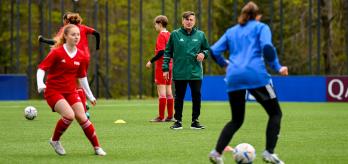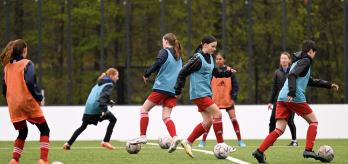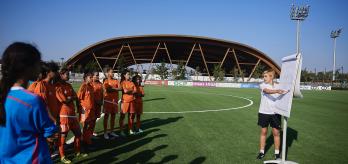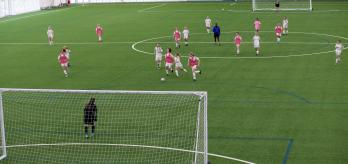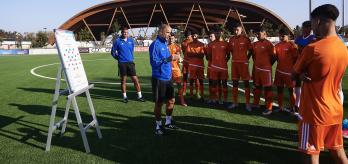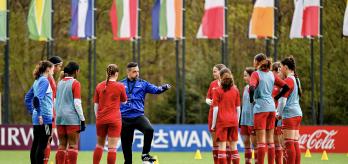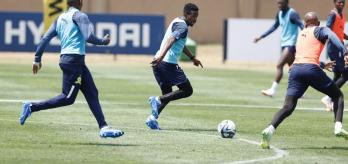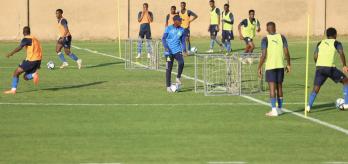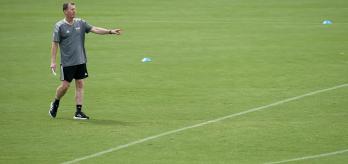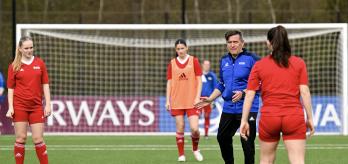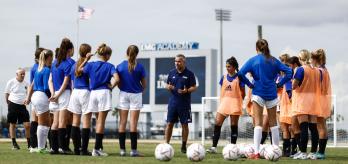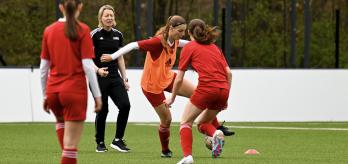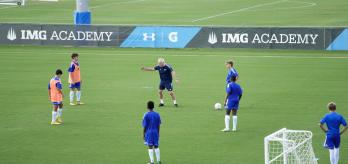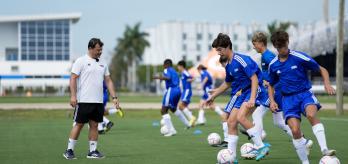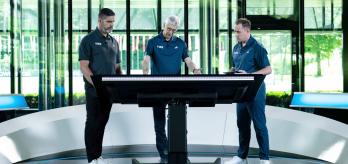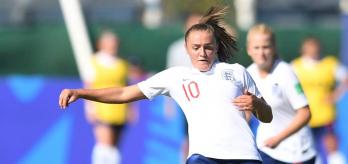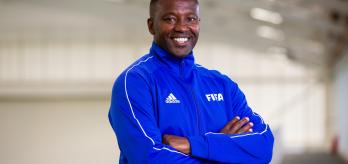A team’s ability to overcome this pressure is heavily dependent on the players’ capacity to turn and exploit the limited space available to them. Players who receive and turn in central areas during the build-up phase are not the only members of the team who have a role to play in such moves. It is important that all players offer well-timed movement and play accurate passes to allow the team to overcome this pressure and progress the move into an attack.
In this session, director of football at Manchester City Women and former head coach of the Denmark and Switzerland women’s national teams Nils Nielsen delivers a series of exercises that focus on receiving and turning with the ball in central areas of the pitch. The session, which is delivered to a group of U-14 girls, gets under way with a simple give-and-go exercise that serves as an introduction and leads into a small-sided possession game. The workout is rounded off with a 6v6 game (plus goalkeepers and a neutral player) that involves building up attacks by playing through central areas.
Session overview
This session requires 13 outfield players and 2 goalkeepers (these numbers can be adjusted to the number of players in your group).
Key coaching points
-
When receiving the ball, take a touch in the direction in which you intend to pass to speed up the movement and make it easier to play through the pressure.
-
Play the ball into your team-mate’s feet when they are stationary and into their path when they are on the move to make it easier for them to receive the pass.
-
Make good decisions on the ball, based on your team-mates’ movement and the opposition’s pressure.
-
Do not force passes if they are risky and instead return the ball from whence it came to retain possession.
-
Wide players should be prepared to make runs off the central player at all times, even before they have received the ball.
-
Look to play passes into central areas to free up space for team-mates in wide areas.
Part 1: turn and give-and-go
The aim of this first exercise is to improve the players’ passing and receiving skills. By focusing on timing of movement, footwork and taking a first touch in the direction they want to pass should allow the players to perform the give-and-go more efficiently.
-
Split the players into two groups of 7.
-
Give each group two balls.
-
Set up two playing areas adjacent to each other in one half of the pitch.
-
Mark out a 5x5m zone in the middle of each playing area.
-
Lay a cone 15m from the midpoint of each side of the central zone.
-
Position 3 players inside the central zone.
-
Place a player at each of the four cones.
-
The exercise is performed with two balls in play at all times.
-
The drill begins with two of the players in the central zone in possession.
-
The two players with a ball in the central zone pass to any player positioned at a cone.
-
One of the players with a ball in the central zone should wait to play their pass two seconds after the other player to ensure that there are 2 players in the central zone at all times.
-
The player follows their pass out of the central zone and performs a one-two with their team-mate at the cone.
-
After the player has played the return pass, they move to the cone occupied by their team-mate at the start of the exercise.
-
This team-mate, who began the exercise at the cone, then plays a pass to the player situated in, or running into, the central zone.This receiving player then begins the sequence again.
Variation 1
- Receiving players inside the central zone are limited to two touches.
Variation 2
- Receiving players in the central zone must turn and play to the opposite side of the playing area.
Variation 3
- The sequence is performed in an anticlockwise direction.
-
Players should time their movement into the central zone to ensure that they receive the ball on the move.
-
When receiving the ball, players should simultaneously turn and take a touch in the direction they want to pass.
-
By playing firm, accurate passes into their team-mates, players will make it easier for them to perform the sequence.
-
The receiving players in the central zone must look to turn as quickly as possible.
-
By delaying their runs into the central zone until a pass is about to be played, players help to keep the tempo of the exercise high.
-
When performing the give-and-go, players should pass using the foot closest to the receiver. This helps to avoid “curled” and challenging passes that require the receiver to take extra touches and slow the sequence down.
-
The receiver of the give-and-go should make sure that they do not get ahead of the ball to make it easier for their team-mate to find them with the return pass.
-
Keep the ball moving at all times.
Part 2: 7v7 multidirectional possession game (plus one neutral player)
In the next part of the session, the principles of receiving and turning with the ball in central areas that were worked on in the previous exercise are put into practice in a small-sided possession game. This exercise gives players the opportunity to work on these skills in an opposed scenario. It helps them to understand how receiving and turning with the ball in central areas allows play to be progressed into the final third, while working on the off‑the‑ball movement required to achieve this.
-
Mark out a 40x40m playing area.
-
Split the group into two teams of 7, plus a neutral player (green), who plays for the in-possession team and operates centrally within the playing area at all times.
-
The blue team look to progress play vertically, while the orange team aim to progress the ball horizontally.
-
For each team, place a wall player and a goalkeeper at opposite ends of the playing area (based on the direction in which they look to progress play, i.e. vertically or horizontally).
-
The objective is for each team to continuously progress the ball from the wall player to the goalkeeper and back again.
-
The coach begins the exercise by rolling the ball to any player positioned in the centre of the playing area.
-
The in-possession team look to progress the ball to either the goalkeeper or the wall player and back again.
-
The out-of-possession team look to dispossess the opposition and progress the ball to either their wall player or goalkeeper and back again.
-
Each time a team progress the ball into their wall player, the passer and the wall player swap positions.
-
If a team progress the ball into their goalkeeper, the passer and the goalkeeper do not swap positions.
-
After a team have progressed the ball into the goalkeeper or wall player, they then look to progress play back to the goalkeeper or wall player on the opposite side of the playing area.
-
The objective is for each team to retain possession for a sustained period, while, at the same time, progressing play.
-
Both teams must use the neutral player as much as possible, particularly as a pivot.
-
Players should either play the ball into their team-mate’s feet (when the team-mate is stationary) or into their path (when they are on the move).
-
Players should apply the principle of turning and taking a first touch in the direction they wish to play.
-
When a player receives the ball in a central area, the team-mates either side of them must immediately move forward into space to offer passing options.
-
To reduce the risk of losing possession, if the central player cannot play a progressive pass, they should play the ball back to the goalkeeper or wall player.
-
However, if a central player is not under pressure when they receive the ball, they should look to turn and drive forward.
-
The players who are ahead of the ball when the central player receives and turns should immediately move forward to be in a position to receive high up the pitch.
-
Players should make good decisions on the ball and avoid forcing passes to team-mates who are under pressure. If it is the safer option, players should return the ball to whence it came to ensure that their team retain possession.
-
Making short runs and drawing opposing players in can open up passing lanes to allow passes to be played through defensive lines.
-
Passes should only be played through one defensive line at a time to minimise the risk of losing the ball.
Part 3: 6v6 game (plus goalkeepers and 1 neutral player)
The final exercise is a small-sided game that allows the players to work on receiving and turning with the ball in central areas to create goalscoring opportunities in the final third. The exercise focuses on the players’ ability to pass the ball when under pressure in central areas to free up space for team-mates out wide.
-
Mark out a 50x40m playing area with two full-size goals.
-
Divide the group into two teams of 6, plus goalkeepers and a neutral player.
-
Set each team up in a 3-1-2 formation.
-
Ask the neutral player to play in central areas and act as an additional midfielder for the in-possession team.
-
The exercise begins with one of the goalkeepers, who plays the ball to a team-mate to start building the attack.
-
The objective is to progress the ball into attack by playing through central areas.
-
Each team look to retain possession and progress the ball to score.
-
When the ball passes the halfway line, the defending team’s 2 forwards must remain in the opposition’s half.
-
When their team are attacking, 2 defenders must remain in their own half to mark the 2 forwards. However, they can still participate in the build-up phase.
-
One defender must join the attack when their team cross the halfway line.
-
The neutral player must play an active role in the attacking phase at all times.
- Ensure that every goal matters by making the scoreline 1-0 to the scoring team. For example, if the team that are trailing score a goal, they are awarded a 1-0 lead.
-
When receiving the ball facing their own goal, players should remember the principle of receiving and turning to open up the pitch.
-
Players on the in-possession team must be patient, as it is better to wait for an opportunity to pass rather than forcing a pass.
-
The ideal time to launch an attack is when a midfielder or the neutral player receives the ball in a central area.
-
Players should make good decisions on the ball, based on their team-mates’ movement and the opposition’s pressure.
-
Players should look to play passes into central areas to free up space for team-mates out wide.














